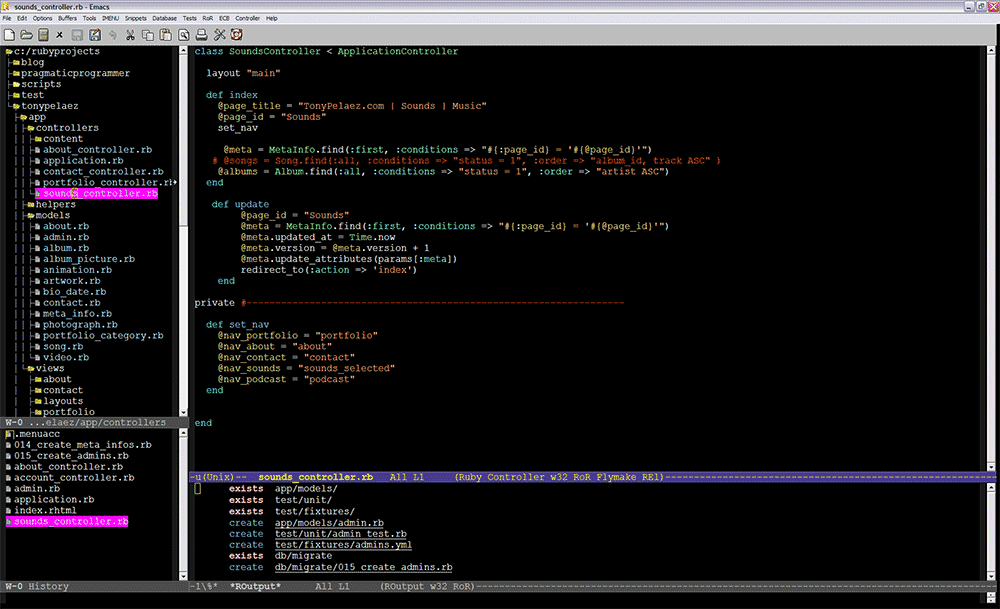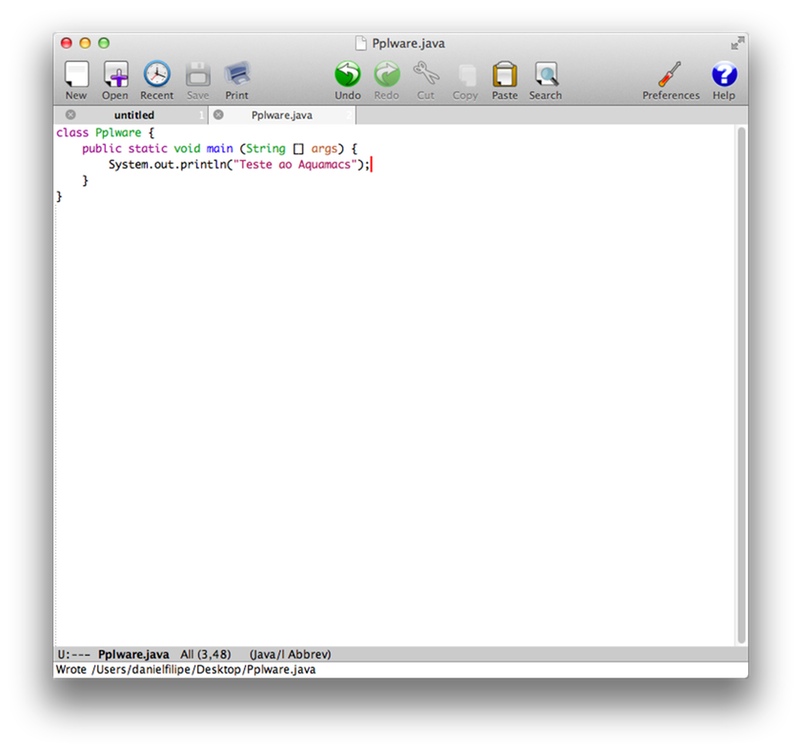There are many alternatives to GNU Emacs for Mac if you are looking to replace it. The most popular Mac alternative is Visual Studio Code, which is both free and Open Source.If that doesn't suit you, our users have ranked more than 100 alternatives to GNU Emacs and loads of them are available for Mac so hopefully you can find a suitable replacement. The Emacs manual tells you: This file, if it exists, specifies how to initialize Emacs for you. Emacs looks for your init file using the filenames `/.emacs', `/.emacs.el', or `/.emacs.d/init.el'; you can choose to use any one of these three names. XEmacs is a highly customizable open source text editor and application development system. It is protected under the GNU Public License and related to other versions of Emacs, in particular GNU Emacs. Its emphasis is on modern graphical user interface support and an. All you need is a (free) AppleID and then you can download it from the Mac App Store found in macOS: Apple Menu App Store. The latest version as of this writing is 8.3.3 and is designed to work. I'm using GNU Emacs 24.4.1 (x8664-apple-darwin13.4.0, NS apple-appkit-1265.21) on OS X 10.9.5 currently, this version is the one from Emacs for Mac OS X and used with It's All Text! For Firefox to write this answer. Obviously most people generally opt for homebrew (as the top answer indicates), but since homebrew has a tendency to screw with /usr/local to such an extent that it won't cope.
Windows
Download at http://ftp.gnu.org/pub/gnu/emacs/windows/
This is the official GNU Emacs, build for Windows by Free Software Foundation.
You'll see file names like these:
- emacs-26.3-i686.zip
- emacs-26.3-x86_64.zip
The “i686” means 32-bit. The “x86_64” means 64-bit.
To find if your Microsoft Windows is 32 or 64, press ❖Window key, type “about” in the search box. It'll bring up “About this PC” window.Look for the line “system type”.
After download, right click “extract all” to unzip it.
Open the folder, open the folder named “bin”, click the “runemacs” to start emacs.

To uninstall, just delete the folder.
[see Emacs in Microsoft Windows FAQ]
Mac
Emacs is installed on macOS by default, but a very old version, version22.1, dated 2007.
In terminal, type:
which emacs→ check if emacs is installed and in your path.emacs --version→ print version.emacs→ launch emacs. (to quit, press Ctrl+xCtrl+c)
Download Latest Emacs for MacOS
Download athttp://emacsformacosx.com/
This is plain GNU Emacs, built by David Caldwell.
Homebrew, Macports
Get emacs from one of the package managers.
- Homebrew http://brew.sh/
- MacPorts https://www.macports.org/
Linux
Build Emacs from Source Code

Download Emacs Binary from apt-get
In terminal, type:
which emacs→ check if emacs is installed and in your path.emacs --version→ print version.emacs→ launch emacs. (to quit, press Ctrl+xCtrl+c)
On Ubuntu, to check available emacs package version for install,
Typicall you install by
sudo apt-get install emacs26
, where the emacs26 may be other version.
If you have a question, put $5 at patreon and message me.
Or Buy Xah Emacs Tutorial
Or buyJavaScript in Depth
| [ < ] | [ > ] | [ << ] | [ Up ] | [ >> ] | [Top] | [Contents] | [Index] | [ ? ] |
Emacs built on the Mac OS supports many of its major features:multiple frames, colors, scroll bars, menu bars, use of the mouse,fontsets, international characters, input methods, coding systems, andsynchronous subprocesses (call-process). Much of this works inthe same way as on other platforms and is therefore documented in therest of this manual. This section describes the peculiarities of usingEmacs under the Mac OS.
The following features of Emacs are not yet supported on the Mac:unexec (dump-emacs), asynchronous subprocesses(start-process), and networking (open-network-stream).As a result, packages such as Gnus, GUD, and Comint do not work.
Since external programs to handle commands such asprint-buffer and diff are not available on the Mac OS,they are not supported in the Mac OS version.
| AG.1 Keyboard Input on the Mac | Keyboard input on the Mac. |
| AG.2 International Character Set Support on the Mac | International character sets on the Mac. |
| AG.3 Environment Variables and Command Line Arguments. | Setting environment variables for Emacs. |
| AG.4 Volumes and Directories on the Mac | Volumes and directories on the Mac. |
| AG.5 Specifying Fonts on the Mac | Specifying fonts on the Mac. |
| AG.6 Mac-Specific Lisp Functions | Mac-specific Lisp functions. |
| [ < ] | [ > ] | [ << ] | [ Up ] | [ >> ] | [Top] | [Contents] | [Index] | [ ? ] |
AG.1 Keyboard Input on the Mac
On the Mac, Emacs can use either the option key or thecommand key as the META key. If the value of the variablemac-command-key-is-meta is non-nil (its default value),Emacs uses the command key as the META key. Otherwise ituses the option key as the META key.
Most people should want to use the command key as the META key,so that dead-key processing with the option key will still work. This isuseful for entering non-ASCII Latin characters directly from the Mackeyboard, for example.
Emacs recognizes the setting in the Keyboard control panel andsupports international and alternative keyboard layouts (e.g., Dvorak).Selecting one of the layouts from the keyboard layout pull-down menuwill affect how the keys typed on the keyboard are interpreted.
The Mac OS intercepts and handles certain key combinations (e.g.,command-SPC for switching input languages). These will notbe passed to Emacs.
The Mac keyboard ordinarily generates characters in the Mac Romanencoding. To use it for entering ISO Latin-1 characters directly, setthe value of the variable mac-keyboard-text-encoding tokTextEncodingISOLatin1. Note that not all Mac Roman charactersthat can be entered at the keyboard can be converted to ISO Latin-1characters.
Emacs For Mac Os X
To enter ISO Latin-2 characters directly from the Mac keyboard, setthe value of mac-keyboard-text-encoding tokTextEncodingISOLatin2. Then let Emacs know that the keyboardgenerates Latin-2 codes, by typing C-x RET k iso-latin-2RET. To make this setting permanent, put this in your`.emacs' init file:
| [ < ] | [ > ] | [ << ] | [ Up ] | [ >> ] | [Top] | [Contents] | [Index] | [ ? ] |

AG.2 International Character Set Support on the Mac
The Mac uses a non-standard encoding for the upper 128 single-bytecharacters. It also deviates from the ISO 2022 standard by usingcharacter codes in the range 128-159. The coding systemmac-roman is used to represent this Mac encoding. It is usedfor editing files stored in this native encoding, and for displayingfile names in Dired mode.
Any native (non-symbol) Mac font can be used to correctly displaycharacters in the mac-roman coding system.
The fontset fontset-mac is created automatically when Emacsis run on the Mac. It displays characters in the mac-romancoding system using 12-point Monaco.
To insert characters directly in the mac-roman coding system,type C-x RET k mac-roman RET, customize the optionkeyboard-coding-system, or put this in your init file:
This is useful for editing documents in native Mac encoding.
You can use input methods provided either by LEIM (see section Q.4 Input Methods) or the Mac OS to enter international characters.
To use the former, see the International Character Set Support sectionof the manual (see section Q. International Character Set Support).
To use input methods provided by the Mac OS, set the keyboard codingsystem accordingly using the C-x RET k command(set-keyboard-coding-system). For example, for TraditionalChinese, use `chinese-big5' as keyboard coding system; forJapanese, use `sjis', etc. Then select the desired input method inthe keyboard layout pull-down menu.
The Mac clipboard and the Emacs kill ring (see section H.7 Deletion and Killing) areconnected as follows: the most recent kill is copied to the clipboardwhen Emacs is suspended and the contents of the clipboard is insertedinto the kill ring when Emacs resumes. The result is that you can yanka piece of text and paste it into another Mac application, or cut or copyone in another Mac application and yank it into a Emacs buffer.
The encoding of text selections must be specified using the commandsC-x RET x (set-selection-coding-system) or C-xRET X (set-next-selection-coding-system) (e.g., forTraditional Chinese, use `chinese-big5-mac' and for Japanese,`sjis-mac'). See section Q.9 Specifying a Coding System, for more details.
| [ < ] | [ > ] | [ << ] | [ Up ] | [ >> ] | [Top] | [Contents] | [Index] | [ ? ] |
AG.3 Environment Variables and Command Line Arguments.
Environment variables and command line arguments for Emacs can be setby modifying the `STR#' resources 128 and 129, respectively. A commonenvironment variable that one may want to set is `HOME'.
The way to set an environment variable is by adding a string of theform
to resource `STR#' number 128 using ResEdit. To set up theprogram to use unibyte characters exclusively, for example, add thestring
| [ < ] | [ > ] | [ << ] | [ Up ] | [ >> ] | [Top] | [Contents] | [Index] | [ ? ] |
AG.4 Volumes and Directories on the Mac
The directory structure in the Mac OS is seen by Emacs as
So when Emacs requests a file name, doing file name completion on`/' will display all volumes on the system. You can use `..'to go up a directory level.

To access files and folders on the desktop, look in the folder`Desktop Folder' in your boot volume (this folder is usuallyinvisible in the Mac Finder).
Emacs creates the Mac folder `:Preferences:Emacs:' in the`System Folder' and uses it as the temporary directory. Emacsmaps the directory name `/tmp/' to that. Therefore itis best to avoid naming a volume `tmp'. If everything workscorrectly, the program should leave no files in it when it exits. Youshould be able to set the environment variable TMPDIR to useanother directory but this folder will still be created.

| [ < ] | [ > ] | [ << ] | [ Up ] | [ >> ] | [Top] | [Contents] | [Index] | [ ? ] |
AG.5 Specifying Fonts on the Mac
It is rare that you need to specify a font name in Emacs; usuallyyou specify face attributes instead. But when you do need to specifya font name in Emacs on the Mac, use a standard X font name:
See section AE.7 Font Specification Options. Wildcards are supported as they are on X.
Native Apple fonts in Mac Roman encoding has maker name appleand charset mac-roman. For example 12-point Monaco can bespecified by the name `-apple-monaco-*-12-*-mac-roman'.
Macbook Emacs
Native Apple Traditional Chinese, Simplified Chinese, Japanese, andKorean fonts have charsets `big5-0', `gb2312.1980-0',`jisx0208.1983-sjis', and `ksc5601.1989-0', respectively.
Single-byte fonts converted from GNU fonts in BDF format, which are notin the Mac Roman encoding, have foundry, family, and character setsencoded in the names of their font suitcases. E.g., the font suitcase`ETL-Fixed-ISO8859-1' contains fonts which can be referred to bythe name `-ETL-fixed-*-iso8859-1'.
| [ < ] | [ > ] | [ << ] | [ Up ] | [ >> ] | [Top] | [Contents] | [Index] | [ ? ] |
AG.6 Mac-Specific Lisp Functions
The function do-applescript takes a string argument,executes it as an AppleScript command, and returns the result as astring.
The function mac-file-name-to-posix takes a Mac file name andreturns the GNU or Unix equivalent. The functionposix-file-name-to-mac performs the opposite conversion. Theyare useful for constructing AppleScript commands to be passed todo-applescript.
| [ << ] | [ >> ] | [Top] | [Contents] | [Index] | [ ? ] |
Install R In Mac
This document was generatedon April 2, 2002using texi2html
